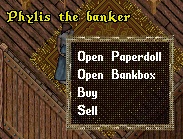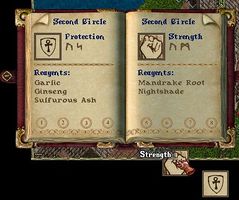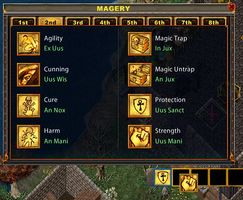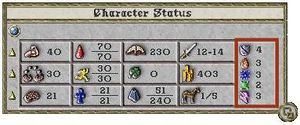Difference between revisions of "New Player Guide: Basics"
m |
m |
||
| Line 197: | Line 197: | ||
</gallery> | </gallery> | ||
|} | |} | ||
| + | |||
| + | |||
| + | <!-- Armor --> | ||
| + | {| cellpadding="10" style="border: 1px solid darkgray;" | ||
| + | | width="120px" valign="top" | | ||
| + | ===Armor & Resistances=== | ||
| + | [[File:Plate Helm.png]] | ||
| + | [[File:Platemail Tunic.png]] | ||
| + | [[File:Platemail Legs.png]] | ||
| + | [[File:Platemail Arms.png]] | ||
| + | | | ||
| + | [[Armor]] is the category of in game items that can be equipped by a character mostly for defensive purposes. It generally has Resistances and other Item Properties used by a character in combat. This distinguishes armor from clothing, which typically does not. | ||
| + | |||
| + | Some (but not all) types of armor can also be categorized more specifically by theme. Suits may or may not contain components for each equipment slot. For example, Leather Armor comes with a head covering while most other sets do not. Furthermore, some sets contain "alternative" Female Armor components. | ||
| + | |||
| + | Note that all types of armor in a given set come with the same basic resistances. For example, a [[Platemail Gorget]] provides exactly the same level of protection as a [[Platemail Tunic]]. Armor that is Exceptionally crafted will receive a bonus that is further boosted by your character's Arms Lore skill, while Runic Tools can be used to send the total resistance level far higher. | ||
| + | |||
| + | Some forms of armor are "medable," meaning they do not affect your use of the Meditation skill when worn. Elven armor can only be worn by Elves. The same way, Gargish armor can only be worn by Gargoyles. | ||
| + | |||
| + | |||
| + | {| cellpadding="10" style="border: 1px solid darkgray;" | ||
| + | | valign="top" | | ||
| + | Resistance is a generic term used to indicate the five areas in which damage is reduced and armor is designed to resist. Every armor piece provide resistance that can be seen by placing the mouse over the item: | ||
| + | |||
| + | |||
| + | *Physical Resistance | ||
| + | *<span style="color:OrangeRed">Fire Resistance</span> | ||
| + | *<span style="color:SteelBlue">Cold Resistance</span> | ||
| + | *<span style="color:ForestGreen">Poison Resistance</span> and | ||
| + | *<span style="color:MediumVioletRed">Energy Resistance</span>. | ||
| + | |||
| + | |||
| + | A character's individual resistances are displayed in the [[#Statistics|Character Status Menu or Character Sheet]]. For Humans and Gargoyles, resistance is cumulative up to a maximum level of 70% in all five areas. However, Elves enjoy an Energy Resistance maximum of 75%, not 70%; the rest of its resistances are capped at 70%. | ||
| + | | width="220px" valign="top" | | ||
| + | {{Infobox item | ||
| + | | name=Leather Tunic | ||
| + | | image=Leather_Tunic.png | ||
| + | | weight=6 | ||
| + | | physicalresist=2 | ||
| + | | fireresist=4 | ||
| + | | coldresist=3 | ||
| + | | poisonresist=3 | ||
| + | | energyresist=3 | ||
| + | | strengthrequirement=25 | ||
| + | | durability=23/48 | ||
| + | }} | ||
| + | |} | ||
| + | |- | ||
| + | | colspan="2" | | ||
| + | <gallery widths="300px" heights="200px" perrow=2> | ||
| + | File:Guide CC character status resistances.jpg|[[Classic Client]] - You can see your current total resistances by clicking on the status icon [[File:Guide CC status icon.jpg]] from the [[New Player Guide: Introduction to the Interface#Paperdoll|Paperdoll]] which will open the Character Status Window. The symbols represent (from top to bottom) the total physical, fire, cold, poison and energy resistance. {{Line Break}}You can equip a piece of armor the same way you equip a weapon: by dragging and dropping the it from your [[New Player Guide: Introduction to the Interface#Backpack|Backpack]] to your [[New Player Guide: Introduction to the Interface#Paperdoll|Paperdoll]]. | ||
| + | File:Guide EC character sheet resistances.jpg|[[Enhanced Client]] - You can see your current total resistances by clicking on the character sheet icon {{Line Break}} [[File:Guide EC character sheet icon.jpg|center]] from the [[New Player Guide: Introduction to the Interface#Paperdoll|Paperdoll]] which will open the Character Sheet. {{Line Break}}You can equip a piece of armor the same way you equip a weapon: by dragging and dropping the it from your [[New Player Guide: Introduction to the Interface#Backpack|Backpack]] to your [[New Player Guide: Introduction to the Interface#Paperdoll|Paperdoll]]. | ||
| + | </gallery> | ||
| + | |} | ||
| + | |||
Revision as of 04:36, 27 February 2012
Basics
Now that you are more familiar with the interface, it is time to take a walk and get to know the town around you. Depending on your starting location, you are now inside the local Inn or the city Bank .
Inns & Banks |
Inns act as lodging places for travelers who seek shelter to rest safely. They are safe places where you can log out instantaneously. Banks provide a place of storage, also known as the |
Context Menu & NPCs |
The term Context Menu refers to a menu accessed by single clicking on something (or holding down shift, then single clicking on something, if one has selected the option to handle it that way). Several game mechanics can be accessed this way. A Non-Player Character (NPC) is any character that is not controlled by a player. The term's polar opposite is Player Character. Although not controlled by players, monsters and animals are not generally considered NPCs. Hostile NPCs are sometimes categorized with other creatures or monsters. Typical examples of NPCs include: Bankers, Minters, Healers, Vendors and Guards. You can also pay NPCs for training your Skills up to a certain level. |
|
| |
Skills |
Ultima Online has 58 different skills currently in game which determine the capabilities of your Character. As a new player, you can expend up to 700 points between these however you desire. In order to improve in a skill you simply carry out the associated actions. For example, if you wish to train as a Swordsman, simply fight Monsters with a sword equipped. Likewise, casting a Fishing Pole out into the water is all it takes to become a better Fisherman. Each skill is associated with certain Statistics, which are trained in the same manner. You can usually pay NPCs for training up to a certain level. For example, visit your local blacksmith's shop and you should be able to learn some of their trade via their Context Menus. You will be expected to pay for these services, of course, though the Gold requested is a pittance. The gold amount is 1 GP per 1/10 of skill with the highest amount of skill costing 400 gold for 40 skill points. |
| |
Statistics |
Stats, an abbreviation of statistics, refers to the three statistics all characters have in varying amounts, as follows:
|
| |
Combat |
There are two kinds of combat:
You can initiate the combat by:
| ||||
| |||||
Note that if you are attacked, you will counter attack automatically, whether or not you're in War mode. | |||||
Spells |
Skilled spell casters are able to attack enemies, aid themselves and allies, move objects and themselves, create things out of nothing, summon creatures and a whole host of other actions that most people imagine when they think of magic. While some spells require the use of components, or reagents, in order to cast them, others do not. Spells are added to spellbooks by dropping an appropriate scroll onto the spellbook in question. Low level spell scrolls can be purchased from NPCs that are located in town magic shops, while high level scrolls can be found as loot on certain monsters. There are eight different spellbooks:
| ||
| |||
Weapons |
Weapons are any items that can be equipped in a character's hands and then used to do either melee or ranged damage to another target. They are wielded using either one or two hands. Weapons can possess a wide range of item properties, including damage increases, swing speed increases, abilities for leeching hit points or mana, casting various spells automatically upon a successful hit, and many more. Weapons are usually categorized by what skill is required to wield them effectively:
| |||||||||||
| ||||||||||||
Armor & Resistances |
Armor is the category of in game items that can be equipped by a character mostly for defensive purposes. It generally has Resistances and other Item Properties used by a character in combat. This distinguishes armor from clothing, which typically does not. Some (but not all) types of armor can also be categorized more specifically by theme. Suits may or may not contain components for each equipment slot. For example, Leather Armor comes with a head covering while most other sets do not. Furthermore, some sets contain "alternative" Female Armor components. Note that all types of armor in a given set come with the same basic resistances. For example, a Platemail Gorget provides exactly the same level of protection as a Platemail Tunic. Armor that is Exceptionally crafted will receive a bonus that is further boosted by your character's Arms Lore skill, while Runic Tools can be used to send the total resistance level far higher. Some forms of armor are "medable," meaning they do not affect your use of the Meditation skill when worn. Elven armor can only be worn by Elves. The same way, Gargish armor can only be worn by Gargoyles.
| ||||||||||||
| |||||||||||||
Previous: Introduction to the Interface |
Next: Hints and Tips |


























